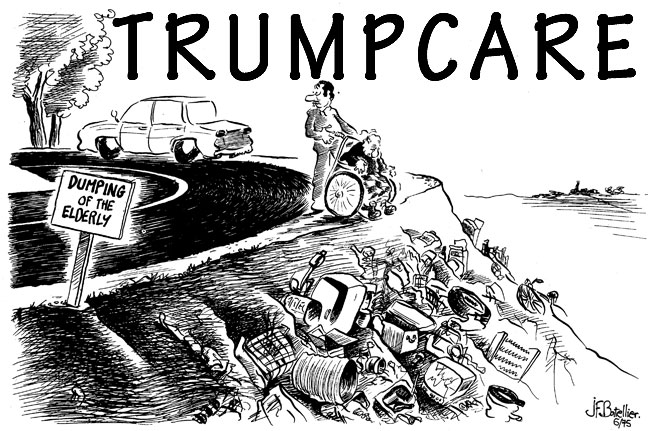
Though drawn in 1975 by Jean-Francois Batellier (and I met him on the street in France in 1982), this came to mind as our future under TrumpCare…
This is the text I wrote in preparation for giving a talk tonight at the exhibition “New Situationists” at the ProArts Gallery off Oscar Grant/Frank Ogawa Plaza in downtown Oakland. I’m not going to read it, but I wanted to sort through my train of thought ahead of time. This is probably rather more articulate than I’ll actually be in person!
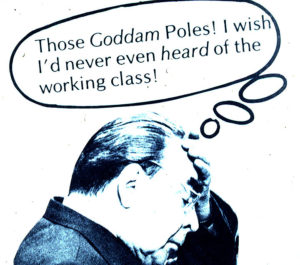
From Processed World #2, during the Solidarity movement’s height in Poland, 1981.
The Situationists seem newly relevant, although for many radicals they never lost their acuity. In late February even the New York Times ran an op-ed by Robert Zaretsky called “Trump and the ‘Society of the Spectacle’, arguing for the relevance of Guy Debord’s seminal work:
With the presidency of Donald Trump, the Debordian analysis of modern life resonates more deeply and darkly than perhaps even its creator thought possible, anticipating, in so many ways, the frantic and fantastical, nihilistic and numbing nature of our newly installed government. In Debord’s notions of “unanswerable lies,” when “truth has almost everywhere ceased to exist or, at best, has been reduced to pure hypothesis,” and the “outlawing of history,” when knowledge of the past has been submerged under “the ceaseless circulation of information, always returning to the same list of trivialities,” we find keys to the rise of trutherism as well as Trumpism.
In his later work, “Comments on the Society of the Spectacle,” published almost 20 years after the original, Debord seemed to foresee the spectacular process that commenced on Jan. 20. “The spectacle proves its arguments,” he wrote, “simply by going round in circles: by coming back to the start, by repetition, by constant reaffirmation in the only space left where anything can be publicly affirmed …. Spectacular power can similarly deny whatever it likes, once or three times over, and change the subject, knowing full well there is no danger of any riposte.”
Actually I think it’s a curious problem to apply this analysis to Trump’s rise, implying as it does that the Spectacle has somehow risen anew on January 20. The point of the “Comments” in the late 1980s when it was written, was to argue that the Spectacle had become fully integrated between east and west, and that the ability of spectacular power to create its own circular logic depended on their being a basically univocal media universe. This was probably most visible in our impression of what life in the one-party state of the Soviet Union was like, but his argument, as I understood it, was that we too were living in a parallel state, where despite apparent “differences” and a so-called “free press” the information in our society too was that of a univocal perspective. I’ve often argued that we live in a one-party state with two factions. Sure the Republicans and Democrats disagree about various priorities, but when it comes to US empire, the rule of property, the dependence on militarism, oil, and autos, and the attendant shaping of the fabric of life to protect and extend the rule of billionaires and their corporate and governmental institutions, no real disagreement exists. In this sense, the true is a moment of the false, as Debord put it, and the deep truth of our lives is never acknowledged—that we are enslaved to a system that allows no real alternatives, and our “freedom” is always overwhelmingly contingent on our obedience, on our complicity in reproducing this world. The hyper-trivialization of mass entertainment, sports, and so-called politics has reinforced this logic for decades, whether the titular head of government was Bush, Clinton, or Obama.
Trump represents a kind of backwards challenge to the Spectacle. Of course his barely literate twitter feed has created a self-referential world unmoored from verifiable facts, a world that—incredibly—millions of people seem to believe in. Trump goes round and round, repeats his Big Lies incessantly and claims that anyone who says different is a the real liar. He and Bannon and the alt-right press are trying to establish hegemony for their version of the self-referential and circular Spectacle, but in so doing, they have underscored that there is not just one Spectacle at this juncture. What Trumpism has done is to crack apart the consensus view of the world. No longer is there a univocal media world full of self-referential platitudes about this being the best of all possible worlds, and anyway, the only one possible (don’t forget Margaret Thatcher’s T.I.N.A. admonition: There Is No Alternative!). Now we have the funhouse mirror Trump world that invites the anti-intellectual and resentful white America to hide in it to avoid the complicated realities of science, multicultural society, rising gender nonconformity, etc. The formal opposition is the previously self-satisfied world of the center-right mass media, the networks and CNN and big city newspapers, who are trying to come to grips with having their hold on power shattered. They are having to actually engage in adversarial reporting, a long lost art. For many of us it is kind of exhilarating to see journalism trying to crack the daily tidal wave of lies, distortions, and distractions. But the premise of this conflict is that Trump and all he represents is the outlier, and somehow the consensus view of reality, i.e., the Spectacle, must be reaffirmed and ultimately supplant the crude propagandists of Trumpism.
But the real wild card here is a resurgent civil society. From the women’s marches to the airport protests, the first weeks of Spectacular instability had millions of people moving into the public sphere directly, acting without waiting for mediation or instruction. Going forward, various organizations with diverse agendas are working to direct and harness the urgent and fertile insurgency percolating among millions of Americans whose expectations of representation are at an all-time low. Very quickly nonprofit organizations, tiny cadres of still-extant professional revolutionaries, and dozens of issue-oriented campaigns have rushed to get in front of this welling energy. A good time, perhaps, to look at the decades-long limits of radicalism between the 1970s and today.
I am no acolyte of the Situationists, nor am I here to suggest we should genuflect before Guy Debord or Raoul Vaneigem. Not long ago I got a call from an old friend who wanted to warn me that my name was associated with this show! He is a smart guy, close to one of the original Situationists, so I guess he thought he was doing me a favor by warning me. I told him I knew I was associated and that I would be speaking here tonight, and that I didn’t have a problem with that. That seemed to puzzle him, but we carried on amiably about other topics after that. I’m sure there are people who consider this gathering, this art show, to be fundamentally parasitical and at odds with the logic of the Situationist critique. In participating, we are essentially reinforcing the preoccupation with consuming images produced by others and the ensuing passivity that was among the main targets of their critique. Worse perhaps, we are turning the original critique and activities of the Situationists into a topic for nostalgic consumption.
That may be true but I don’t think we can let that concern stop us from gathering and talking. Few people even know who the Situationists were, let alone the people around the Bay Area who in some way were inspired by aspects of their practice. This show, for whatever obvious flaws and gaps it holds, is nevertheless an opportunity to encounter long-forgotten materials and in the ongoing series of public events, a chance to meet and talk and think about the world we’re in, precisely without the mediation of experts or editors.
My main reason for agreeing to speak is not to revisit various projects I’ve been involved in over the years—though I’m going to do that too. My primary point tonight is to highlight the cul-de-sac that nearly 40 years of radical politics has left me in, and not just me, but everyone who shares a commitment to a world radically different than this one. There are myriad reasons for finding ourselves in this predicament and I don’t have all the answers any more than you do. But I do think I’ve participated in creating a culture that has pushed us into this dead-end. For as long as I can remember I have been surrounded by a political culture that has been preoccupied with pursuing some version of perfection, finding the ultimate critique, and finding fault with all efforts that anyone actually engages in to change the world. A key to this is the ironic stance.
From the ironic stance, we protect ourselves from getting dirty. We keep our distance and can joke about anything. In that comfortable perch we tossed our mental hand grenades where we wanted to, not concerned about any fallout, nor thinking much about what else we might do. Still, whenever anyone came along who expressed genuine belief in practical activity that might change things, we scoffed. “Impossible! Clearly you don’t ‘get it’! Only a chump would think anything so naïve!” If you didn’t want to join us on the ironic perch, you must be hopelessly naïve.
There were exceptions of course, and we were seeking radical ideas and approaches. But I think we were oblivious to the role our commitment to irony and sarcasm had come to play in holding us back, in preventing us from engaging in the day-to-day realities that we’d have to face if we really wanted to change life. It’s not far from irony to cynicism, but I think most of the sarcasm and irony I’ve helped create has avoided cynicism even while it targeted hypocrisies, absurdities, contradictions, and genuinely empty gestures. Being subjected to the critical, ironic gaze can be demoralizing and even debilitating. The main problem with irony is that it has rendered sincerity implausible. If you are comfortably ensconced in an ironic gaze, anyone who speaks from their heart with sincerity just sounds like a manipulator, a liar, or a chump. The presumption is that if they don’t share the ironic distance and have actually fallen into the trap of thinking that their feelings and ideas matter—or can matter—then they by definition are unsophisticated. This invalidating attitude has badly crippled political discourse in our culture. It’s certainly not the only reason anti-capitalist radicalism is stuck, but we’re deluding ourselves if we don’t recognize it is one of the impediments we’ve imposed on ourselves.
I think we can debate any given project or intervention and try to make sense of its social meaning and impact. But underlying the critique too often is the assumption that anything anyone does is already fundamentally co-opted, or to use the language we were fond of once upon a time, recuperated. Put another way, if you engage in an effort to change something, since it is almost never the totality of life, it is therefore only a simulacrum of radicalism. The only acceptable act to participate in—and this has historically been the position of those who most ardently claim the banner of the Situationists, usually referred to as pro-Situs—is complete revolution. These days this impossible standard is often hurled about by anarchists and the new communisation radicals as a way of dismissing anyone who doesn’t share their totalizing critique. Of course the problem of what to do faces everyone in this uncomfortable cul-de-sac of radicalism. The idea that the way out is to talk to people with whom you disagree, to organize among people who don’t share all the radical reading and principles that have informed your own ideas, is dismissed as a version of selling out. Maintaining the purity of our untarnished radical ideas is far more important than addressing the real world in any practical way.
This came home again during the massive Women’s Marches the day after Trump was inaugurated. I went to both the Oakland and San Francisco marches and was moved nearly to tears at various moments by the heartfelt sincerity being expressed in the thousands of homemade signs. It happened again at the airport during the wild protests against the Muslim travel ban. On social media though, a steady drip-drip-drip of disapproval quickly emerged. Where were these people during the past eight years of Obama’s horrible immigration policies? Where were they when police gunned down so many people of color with total impunity? etc. etc. In this case irony was left behind for fairly straightforward denunciations of the lack of depth, sincerity, or commitment of the millions who took part in these public rebukes to Trump. This politics of denunciation has always been at the heart of the Situationist practice, and even though so few people have ever heard of them, or if they have, know so little about what they actually thought or did, this sectarian bitterness has deeply penetrated radicalism in all its variations. What a strange and self-defeating approach it is! Finally millions of people seem to be moving, willing to act publicly as political agents, and instead of engaging with them and welcoming them and encouraging a deeper reflection on the continuity and history of the politics they are opposing, they are all written off before the conversation has even begun. They are all white. They are all middle class. They are Democrats. They aren’t already just like me!
It’s hardly a surprise that there is an anti-intellectual backlash. It’s hardly a surprise that “political correctness” has become the label of a whole range of sneering, condescending attitudes and behaviors that have driven potential allies into the arms of the crazy right. An awful lot of radicals have spent most of the past few decades perfecting their own ideas and behaviors and doing their utmost to make those the standard by which they judge everyone else. If you buy the wrong products, eat the wrong food, use the wrong technology, or simply cope with life in ways that the radical has chosen differently, you are beyond the pale and finding practical alliance is not possible. On the contrary, people who “behave badly” are written off as the irredeemable enemy.
To be sure, even if the Situationists were famous for their expulsions and denunciations, such sectarianism has much longer roots. The Stalinists took this logic to the extreme, leading to mass murder on an unprecedented scale in the Soviet Union of the old Bolsheviks in the 1937 show trials for example. In the U.S. the Communist Party in the late 1940s decided to embrace a hardline Stalinism and reversed the popular front openness they had been centrally involved in. Suddenly anyone who wasn’t following the precise contours of the “party line” became enemies, especially those with either Trotskyist sympathies or more radical ideas than the top-down authoritarianism of the party.
My Own Trajectory
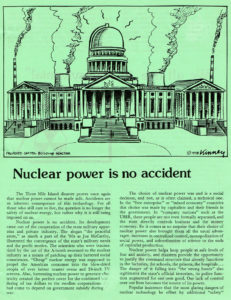 I’ve been around radical politics since about 1979 when I met a group calling itself the Union of Concerned Commies. In San Francisco’s Civic Center, I was handed a flyer at the one-year anniversary of the Three Mile Island nuclear accident in Harrisburg, PA called “Nuclear Power is No Accident.” As I had been an anti-nuclear activist myself for several years I was excited to read this clear and funny flyer and within a few weeks I was hanging out with the group.
I’ve been around radical politics since about 1979 when I met a group calling itself the Union of Concerned Commies. In San Francisco’s Civic Center, I was handed a flyer at the one-year anniversary of the Three Mile Island nuclear accident in Harrisburg, PA called “Nuclear Power is No Accident.” As I had been an anti-nuclear activist myself for several years I was excited to read this clear and funny flyer and within a few weeks I was hanging out with the group.
It was a group that characterized its constituent parts around the Bay Area as “the milieu;” as I entered the scene a bitter fight was ongoing over a “Minimum Points of Unity,” an effort that never reached its goal. The various folks populating this mysteriously self-important “milieu” were not of a uniform political orientation. Some were pro-Situ, that is, people who saw themselves as carrying on the vibrant and uncompromising radicalism of the Situationists. That there were several different strands of this only made the certainty they each had that they were the true heirs of the Sits more hilarious (especially in retrospect). Others saw themselves as connected to a long thread of anti-Bolshevik left communists with notable roots in the failed German Revolution after WWI, while some others were more anarchistic, less intellectual and theory-minded, more interested in action.
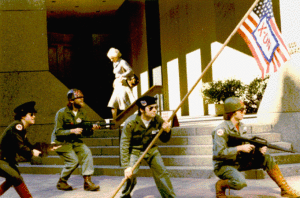
Union of Concerned Commies, aka John Wayne Peace Institute, on Market Street, spring 1980.

Le Tank Solaire, the defense program for the ’80s and ’90s… allowing any citizen to make sorties from their own garage!
The group had at least two dozen participants and didn’t hold together too well. After a hiatus during the last half of 1979 I returned to a meeting in early 1980 at which everyone was very despondent. I proposed that we don surplus military fatigues and declare martial law, since the whole “America Held Hostage” Iranian crisis seemed to lead in that direction. Take the implied trajectory and push it further, a technique that took the absurdity of what we faced and push it to its logical insane conclusion. This was enthusiastically embraced and for the next six months or so, the Union of Concerned Commies became an odd type of street theater group, appearing downtown, on Sproul Plaza at Berkeley, at political rallies in the Civic Center, and so on. Before long we were friends with the Reagan for Shah Committee and its auxiliary Ladies Against Women, as many people began to take up the ironic approach to political dissent in that moment (not that it was particularly new).
The Situationists were famously associated with detournement of graphic art—taking comics or other popular images and putting different words in the captions. After the demise of the UCC, the next project to emerge was Processed World magazine, the first issue of which appeared in April 1981 after a long gestation from the fall of 1980. Right away the magazine took up the graphic style of détournement, a way to reveal the real meaning of bland corporate advertising, or to lampoon such “messaging” with the less masked messages we created as fake ads.

from Processed World #1, April 1981
But with this effort we soon found ourselves fully immersed in the kind of sectarian bitterness that the Situationists had so famously engaged in. Expulsions and denunciations were nipping at our edges even if some of us were trying to avoid that whole self-immolating path. After the first issue we rejected a letter by a local anarchist that personally attacked one of the first issue’s writers, and that led to accusations of “censorship.” By the 5th issue of the magazine, one of the earliest participants, Gigit Digit, quit the project because, according to her, we were being dishonest by not laying out in detail our various inspirations and revolutionary antecedents—even if it would’ve been impossible to identify anything common among the now more diverse members of the Processed World collective at the time.
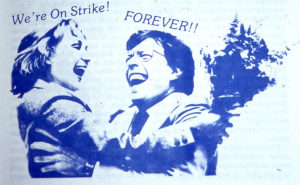 Her departure led soon thereafter to two more self-styled radicals leaving the project, denouncing those who continued as reformists or somehow insufficiently radical. We carried on with our shared vision of a magazine that facilitated discussion across workplaces and distances, trying to come to grips with the early changes being wrought by neoliberalism and automation. Our sense of humor remained intact and the irony and sarcasm that underscored Processed World as “the magazine with a Bad Attitude,” continued on without a break.
Her departure led soon thereafter to two more self-styled radicals leaving the project, denouncing those who continued as reformists or somehow insufficiently radical. We carried on with our shared vision of a magazine that facilitated discussion across workplaces and distances, trying to come to grips with the early changes being wrought by neoliberalism and automation. Our sense of humor remained intact and the irony and sarcasm that underscored Processed World as “the magazine with a Bad Attitude,” continued on without a break.
 Most of us were in our 20s or early 30s in those days and we passionately defended our radicalism against attacks from all sides. We had great scorn for liberals who were still delusional enough to imagine that the claims of democracy and constitutional order were actual descriptions of our daily lives. We also kept our distance from the shrinking marxist-leninist party-builders, as well as the crazy primitivist anarchists who sought to destroy technology and civilization without imagining that they were calling for unprecedented mass murder in doing so.
Most of us were in our 20s or early 30s in those days and we passionately defended our radicalism against attacks from all sides. We had great scorn for liberals who were still delusional enough to imagine that the claims of democracy and constitutional order were actual descriptions of our daily lives. We also kept our distance from the shrinking marxist-leninist party-builders, as well as the crazy primitivist anarchists who sought to destroy technology and civilization without imagining that they were calling for unprecedented mass murder in doing so.
As the 1980s wore on, the old and new left seemed to disintegrate around us. By the time the Berlin Wall was punctured in 1989 leading to the demise of the Soviet empire, Processed World too was beginning to repeat itself. It still published five more years but finally in 1994 it ended in a cloud of pot smoke and beery acrimony. (We came back to publish issues in 2001 and 2005, but there will never be another.)
Already by the time Processed World fell apart, Critical Mass had taken over a lot of our most hopeful and creative energy, at least for those of us who were daily cyclists. In 1992 a couple of dozen friends who were meeting informally around the edges of Processed World, mostly at our office, gave rise to Critical Mass, the monthly bike ride that spread to over 400 cities around the world. As cyclists we were keenly aware of the absurdity of modern cities’ dependence on private automobiles and had for the most part decided to exit that madness. During the first effervescent years of the experience “xerocracy” allowed lots of people to express themselves, often, but not exclusively, employing an ironic tone.
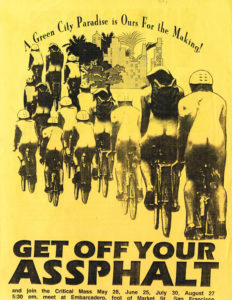
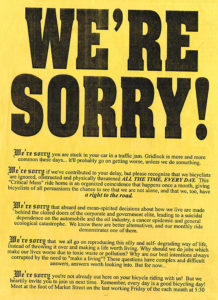
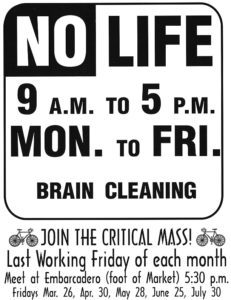 Critical Mass gave new space for earnestness too, that finally began to break with the ironic stance. Not that we didn’t have fun, too. One of my favorite handouts was our flyer that said in big black type at the top: We’re Sorry! Critical Mass was always about much more than bicycling though. It was in my mind primarily dedicated to opening a new kind of public space. And as I argued in a number of flyers and essays over the years, when you participated in the ride, you were rolling through public streets en masse, talking and arguing, sharing ideas, shortcircuiting the normal mediated experience that dominates our lives. In this sense, the bicycle became an anti-Spectacular device, facilitating a more direct and engaged experience of daily life.
Critical Mass gave new space for earnestness too, that finally began to break with the ironic stance. Not that we didn’t have fun, too. One of my favorite handouts was our flyer that said in big black type at the top: We’re Sorry! Critical Mass was always about much more than bicycling though. It was in my mind primarily dedicated to opening a new kind of public space. And as I argued in a number of flyers and essays over the years, when you participated in the ride, you were rolling through public streets en masse, talking and arguing, sharing ideas, shortcircuiting the normal mediated experience that dominates our lives. In this sense, the bicycle became an anti-Spectacular device, facilitating a more direct and engaged experience of daily life.
It was during the early exciting times of Critical Mass and not long after we stopped publishing Processed World that I decided to take up the challenge that started with Debord’s Comments on the Society of the Spectacle when he described the integrated spectacle’s five principle features:
1) incessant technological renewal; 2) integration of state and economy; 3) generalized secrecy; 4) unanswerable lies; and 5) an eternal present
It became clear to me during the previous years that we live in a fundamentally amnesiac society. Describing it as an “eternal present” Debord gets to the point:
“The manufacture of a present… which wants to forget the past and no longer seems to believe in a future, is achieved by the ceaseless circularity of information, always returning to the same short list of trivialities, passionately proclaimed as major discoveries. Meanwhile, news of what is genuinely important, of what is actually changing, comes rarely, and then in fits and starts.”
Seeing my own life technologically unraveled in the early 1990s (end of typesetting, rise of desktop publishing) I was groping for what to do next. During the mid-’90s buzz around “interactive multimedia” we started working on what eventually became Shaping San Francisco. It continues today, with our Foundsf.org archive and public Talks and Tours and extensive work with local universities and historians and historical groups. In our small way, perhaps we’ve made the fantasy of an eternal present a bit harder to maintain, and by systematically archiving lost moments of radicalism during past decades, our ardent hope is that new initiatives can arise that sidestep the obvious impediments and pitfalls of the past.












I love this. Thank you.